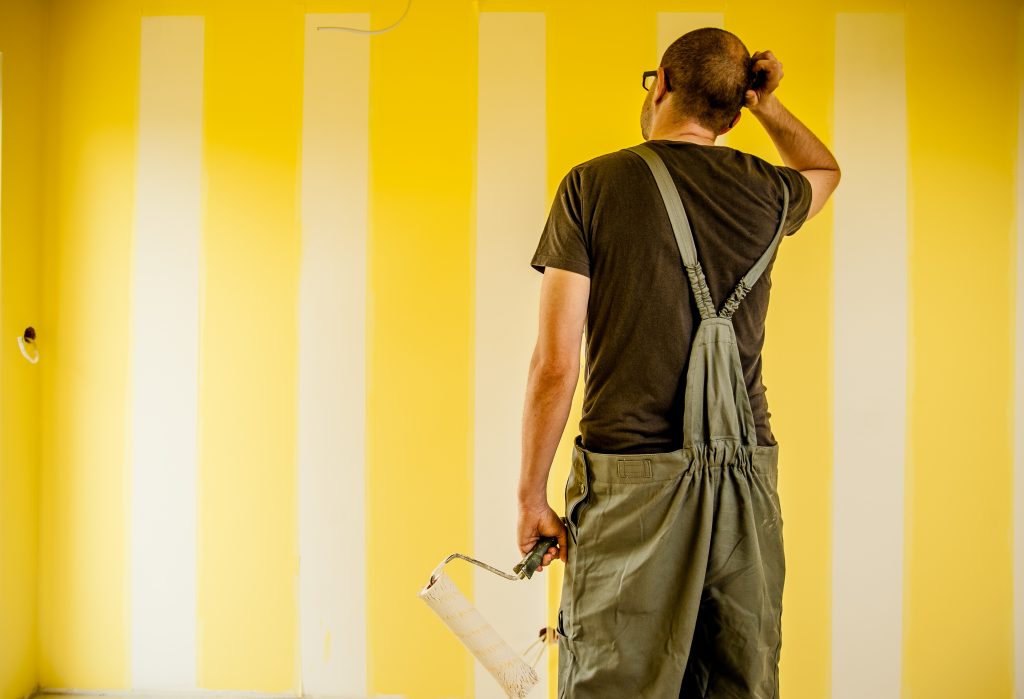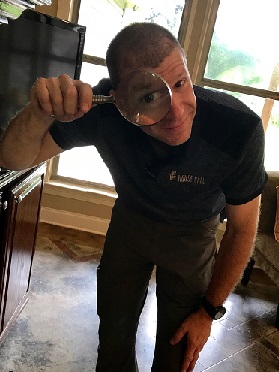Note: This article is part 2 of a series. Click here to read part 1.
So, it’s finally happened. We tried to be as careful as we could be, but it still happened. After all this time, we’ve finally joined all those other careless home inspectors in the “I broke something” club. Accidents happen, and they happen to all of us, eventually. The important thing is for us to keep our cool, try not to stress, and figure out exactly what we’re supposed to do next.

Every situation that we find ourselves in while doing an inspection is unique: different buyers, different sellers, different agents, different houses. Why should this be any different? We’ve got to quickly gather as much information as we can about the dynamics of our current circumstance and move it to a successful remedy.
As each situation is different, the outcome (as well as our role in that outcome) is going to be unique. Each inspection brings its own set of challenges, typically driven by the personalities of the individuals involved. By analyzing our current state of affairs, examining all the different circumstances and thinking about the various outcomes and their affect on us and our future business, we can situate ourselves to move the process forward toward the best outcome.
Continuing with our list of “Accidental Instances,” we’ll begin with a situation that happens more often than we’re aware of:
2. The set up
Sometimes we’re doing an inspection and we break an item, but something just doesn’t seem right. Either the thing breaks without us doing much of anything, or there’s something that just doesn’t feel right about the situation. It seems a little bit too convenient that the item fell apart as soon as we thought about touching it. Or we start looking around and there are some clues that things might not be as they appear. Our Spidey-sense starts tingling…
Thankfully for us, these things don’t happen too often, but then reality is that sometimes they do. Some people are well aware of what it is that home inspectors do, and they devise a plan to have their friendly, neighborhood home inspector pay for some of the needed repairs on their home.
It’s pretty simple, really. Set things up so it looks like everything’s working fine; wait for the unsuspecting inspector to show up, touch it and it falls apart. From there it’s pretty easy to pin the blame on the inspector and get us (or our insurance company) to pay for the repairs. A little pressure applied to the inspector by the seller or their agent seems to work wonders. Maybe it’s a call to our office, a threat to post a negative social media review, or a demand letter from an attorney. It’s usually easier for us to pay for the repair than it is to fight. All because we got set up.
In my earlier years of doing inspections, I came across a set up that (thankfully) ended up going my way. I was inspecting a vacant house where my buyers and their agent were not going to be able to attend. The listing agent, who also happened to be the seller of the property, was the only one present at the inspection. She was courteous, let me into the house and proceeded to work on her computer while sitting at the kitchen counter.
I was almost done and was wrapping up the attic portion of my inspection when it happened: I tripped while walking back to the attic stairs. I started falling towards the partially decked floor of the attic; it seemed to happen in slow motion, just like you’d see in a cartoon. I was slowly moving forward, arms flailing as the ceiling joists and pink insulation slowly approached. I remember simultaneously thinking “boy, this is gonna hurt” and “what’s the name of that sheetrock guy I used, Jim? I think I’m gonna be calling Jim very soon.”
Most of my weight was absorbed by the ceiling joists, but my arm landed between the joists and soon I was looking through a large hole in the ceiling at the insulation-covered floor of the hallway. As I lay there, partially stunned by what had just happened, I could hear the listing agent’s high heeled shoes clicking across the hardwood floors, rapidly approaching the hallway that was now covered by the pink evidence of my mishap.
Happiness is not the absence of problems, it’s the ability to deal with them.
Steve Maraboli
As I lie there in that instant, trying to figure out exactly what it was that I was going to say, I looked at the top side of the ceiling drywall, that happened to be a few inches away from my face, and noticed something unusual. The drywall appeared to be wet, as if something had been leaking nearby and had soaked the drywall that was hidden beneath the blown fiberglass insulation.
I was still lying prone across the attic floor, staring face to face with the agent, who was looking up at me through the new hole in her hall ceiling. She was obviously surprised to see me, and thankfully was more concerned with my well being than with her damaged ceiling, as the first thing she asked was if I was OK. Once I assured her that I was not hurt, her concern quickly pivoted to the hole in her ceiling as she asked what had happened.
To this day, I’m still not sure where I pulled my answer from, but it just seemed to form on my lips as I was speaking, as I certainly didn’t conjure it up ahead of time. I explained to her that while inspecting the attic, I noticed what appeared to be an area of drywall that looked like it was wet. I went on to describe how the ceiling had collapsed just as I had reached out to feel whether it was, in fact, wet.
For what seemed like an eternity, but was likely only a few seconds, we sat there looking at each other, waiting for the other to flinch. She stood there looking up through the hole in her previously in-tact ceiling while I looked down at her from the attic, pieces of drywall and insulation dangling down, held in place by the painted pieces of drywall paper that was once her hallway ceiling.
To my utter surprise, she blurted out the following: “I told my damn husband that you were going to find that wet ceiling; I’m calling his ass right now to come over here and fix this” while she stomped back into the kitchen. Once she was out of sight, I managed to climb to my feet while grinning from ear to ear and wondering exactly how the hell I pulled that answer from thin air.
While not every set up ends this well for us, it’s important to be aware of what’s going on during the inspection. It’s all too easy to become a robot, entranced in the repetition of our jobs, and not notice the often-subtle little clues that we’re being set up. We’ve got to fight against the pull to become an inspection zombie, and keep our wits about us when we’re working, staying aware of the situation and our surroundings, in an attempt to keep from falling prey to the set up.
3. The P.O.S.
All too often it seems, we’re called upon to inspect a house that would likely benefit more from the touch of a bulldozer than a home inspector. It seems like we can’t walk 5 feet ahead without checking off 6 different boxes in our inspection software. And it’s exactly this kind of house where the owner’s going to try to blame us when sometime comes up “broken” after the inspection.
One of my inspectors was working on a P.O.S. home when we had the unfortunate luck of breaking the garage door while testing the opener. He called me from the house, explaining that he had opened the garage door and was trying to test the eye beam by interrupting the sensor when the door bucked at the j-bar attachment point. He was able to get the door to close again, but it was obvious that the attachment at the top of the door was damaged. I told him to document the damage in his report, and that I would handle contacting the listing agent to explain what happened.
After a quick internet search to find the listing agent, I placed a phone call to discuss what had happened. I explained that the inspector was simply performing an inspection step required by our state’s Standards of Practice, testing the eye beam safety feature, when the door was damaged. I explained that the inspector told me that the door was already in bad shape, and that the sellers should contact a garage door repair person to have it properly repaired, as the damage was going to be included in the inspection report.
The agent quickly became irate and told me that there was absolutely nothing wrong with her clients’ garage door, as they parked both of their vehicles in the garage every day. She placed the blame solely on my inspector and demanded to know what I was going to do about getting the door fixed.
As I’ve learned over the years never to commit to any repairs until I’ve had a chance to fully investigate, as surprisingly, some people tend to stretch the truth a bit when it comes to real estate transactions, I told her that I would take a trip to the house to take a look at what had happened for myself before committing to anything.
Every problem is a gift – without problems we would not grow.
Anthony Robbins
Upon arriving at the home but before knocking on the door, I walked over to the closed garage door to do a little investigating. The door, like the rest of the house, was in pretty bad shape. It was apparent that little to no maintenance had ever been done on the door, and small cracks were visible up and down the center of the door, right where the middle row of hinges are attached. I could tell from the visible weathering that those cracks had been there for some time.
After knocking on the door and introducing myself to the homeowner, she led me to the garage. I was not surprised to find that her garage was full of junk, and it was apparent that it had been quite some time since someone had parked a vehicle in that space.
While the homeowner was rambling on about how the inspector had destroyed her garage door, I walked over to the center of the door. Without having to do too much investigation, my suspicions were confirmed: the garage door was in just as bad a shape as the rest of the house. I could easily see that the center bracket had been previously ripped from the door, and someone had attempted to repair the center of the door by jamming a 2” x 4” under the metal where the j-bar was attached.
In my mind, the only mistake that my inspector had made was to even try to test such a deficient door in the first place. I explained to the homeowner that her door is clearly in need of repair, but not by the inspector or my company. As the amount of evidence that she clearly had problems with this door before the inspector arrived at her house began to grow as I pointed them out, her arguments to the contrary began to disappear. I explained that the inspector did exactly what he was hired to do, find problems with the house, and told her that the responsibility to repair her door (again) was entirely on her.
I also suggested that she get someone a bit more qualified than the last person she hired to fix it.

Incidentally, I’ve implemented a new P.O.S. charge in my inspection fee structure. If I can tell by my pre-inspection research that I’m going to be walking into a piece of crap inspection, I make a return call to the client to let them know that there’s going to be an additional fee added to the inspection. Sometimes my P.O.S. fee has its desired result, and the client cancels the inspection, and sometimes I still end up inspecting the crap house, but at least now it’s at a higher fee more commensurate to the amount of work involved. There’s also the added bonus of being able to recommend another inspector, whom I don’t really care for too much, to the clients who decide to cancel due to my increased price!
I’ve also added a new check box to my inspection report, which (in more delicate terms) states that the house is a P.O.S., and that my report is not going to touch on every deficiency on the property, simply a representative number of deficiencies in each area of the home. I also recommend follow up by every major classification of contractor prior to the end of the inspection period to determine costs of correction of all deficiencies present in the home, whether they were noted in the inspection report or not.
Check in next week (part 3) for a look at two more situations we may encounter when we break something on an inspection: the don’t worry about it and the bag of hot air.
I welcome all feedback (both positive and negative) on this post.
Please take a moment to leave a comment below. Thank you!
Want to be an Influencer in Your Field? Share This Post!
Thanks, Joe

